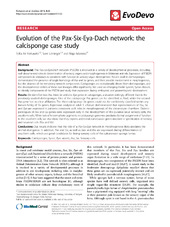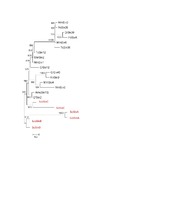| dc.description.abstract | Background: The Pax-Six-Eya-Dach network (PSEDN) is involved in a variety of developmental processes, including well documented roles in determination of sensory organs and morphogenesis in bilaterian animals. Expression of PSEDN components in cnidarians is consistent with function in sensory organ development. Recent work in demosponges demonstrated the presence of single homologs of Pax and Six genes, and their possible involvement in morphogenesis, but the absence of the remaining network components. Calcisponges are evolutionarily distant from demosponges, and the developmental toolkits of these two lineages differ significantly. We used an emerging model system, Sycon ciliatum, to identify components of the PSEDN and study their expression during embryonic and postembryonic development. Results: We identified two Pax, three Six and one Eya genes in calcisponges, a situation strikingly different than in the previously studied demosponges. One of the calcisponge Pax genes can be identified as PaxB, while the second Pax gene has no clear affiliation. The three calcisponge Six genes could not be confidently classified within any known family of Six genes. Expression analysis in adult S. ciliatum demonstrated that representatives of Pax, Six and Eya are expressed in patterns consistent with roles in morphogenesis of the choanocyte chambers. Distinct paralogues of Pax and Six genes were expressed early in the development of the putative larval sensory cells, the cruciform cells. While lack of known photo pigments in calcisponge genomes precludes formal assignment of function to the cruciform cells, we also show that they express additional eumetazoan genes involved in specification of sensory and neuronal cells: Elav and Msi. Conclusions: Our results indicate that the role of a Pax-Six-Eya network in morphogenesis likely predates the animal divergence. In addition, Pax and Six, as well as Elav and Msi are expressed during differentiation of cruciform cells, which are good candidates for being sensory cells of the calcaronean sponge larvae. | en_US |














